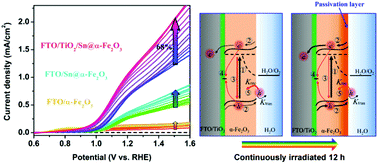Self-improvement of solar water oxidation for the continuously-irradiated hematite photoanode†
Abstract
Improving bulk- or surface-properties has been found as an effective route to regulate and enhance the photoelectrochemical (PEC) performances of some metal–oxide photoelectrodes. However, both bulk and surface self-improvement resulting from the photocharging (PC) effect is rarely reported and as a result the underlying mechanism of the PC effect is not fully understood. Here, we demonstrate that the hematite photoanode integrated with Sn doping and a TiO2 underlayer shows a substantial increase in the photocurrent density (i.e., from 0.69 to 1.12 mA cm−2 at 1.23 V relative to the standard hydrogen electrode) and a cathodic shift of the onset potential after being irradiated by a one-sun simulator for 12 h. The primary reasons for these can be categorized into two fundamental factors: (1) the enhanced bulk conductivity and the resulting decrease in carrier bulk recombination from the gradually increasing ratio of Fe2+ and Fe3+; (2) the reduced carrier surface recombination from the photogenerated passivation layer. Ultimately, both the bulk and surface electrical properties of the hematite photoanode are substantially self-improved under continuous irradiation. This work deepens the understanding of the PC effect and proves that it is a promising technique for the PEC-performance enhancement of the hematite photoanode.



 Please wait while we load your content...
Please wait while we load your content...